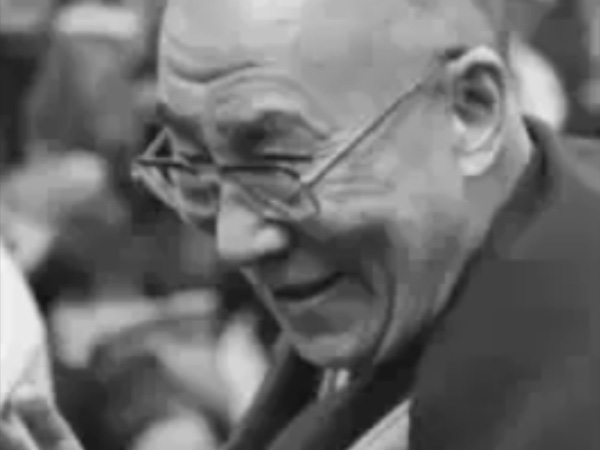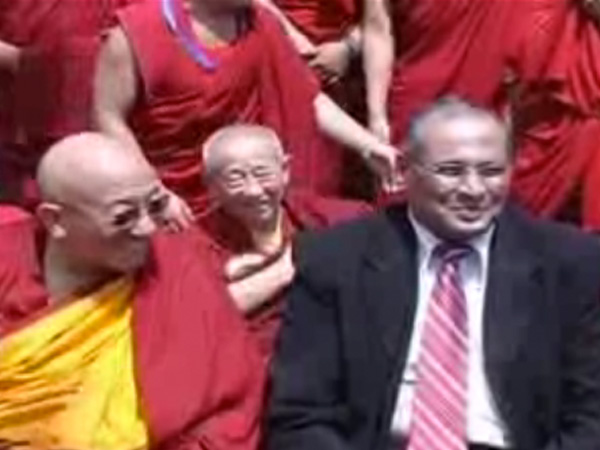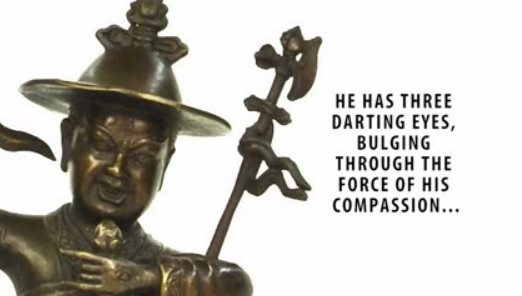DHARMA READINGS
| THE SECRET OF THE MIND IS YAMANTAKA AND THE WRATHFUL ONES | | Print | |
Page 1 of 5  Vajrabhairava Yamantaka: A Tantric initiatory vision “The secret of the body is Vairochana and the Dhyani Buddhas; The form of Yamantaka represented here is known as Ekavira, the “Solitary Hero”. The Sanskrit term Vajrabhairava means the “Adamantine Terrifier” and Yamantaka means “Remover of the Obstacle Yama (the Judge of the Dead)." Readers' Comments
This impressive sculpture, done in wood and finished with multi-colored lacquer, has a height of 52.25 inches (132 cms). Collected by the American artist George Grey Barnard, in Tibet, before World War II, for many years it was on loan to the Museum of Natural History in New York and is now in the permanent collection of the Virginia Museum, Richmond. It has been radiocarbon dated at between 1150 to 1290 C.E., which is the early Yuan period, falling comfortably within the reign-period of Kublai becoming Supreme Khan and Emperor of Mongolia and China (in 1260 C.E.). Immediately, following Kublai Khan’s becoming Supreme Emperor, Karma Pakshi (1204-1283), the second Karmapa hierarch traveled to China, spending six years there and became the Supreme Teacher of this Emperor. It is known that Kublai was initiated into the mysteries of Yamantaka. The date-range of this magnificent Tantric sculpture also falls comfortably in the period of the Nepalese Master sculptor/artist Aniko’s long stay in China at the request of Kublai. The unusual iconography, style, choice of materials and overall effect of this impressive image suggests that it is indeed a masterwork done by Aniko or his immediate entourage.
This Tantric vision The central main hands of the deity hold a chopping-knife (karttrka) and human skull-bowl (kapala), colored gold and ornamented by pearl chains, flammiforms and scepters (vajra). The lower main hands hold a magical knife (purba) and the severed multi-faced head of Brahma the Creator. The upper main hands hold a red right hand which is holding an arrow and an elaborately decorated golden shield, with a Chinese-style makara or dragon face at the center. The other hands hold a ritual scepter (vajra), lance, axe, double-drum (damaru), Wheel of Law (dharmachakra), dagger, swirling flames, ritual bell (ghanta), skeleton-staff (khatvanga), banner, a red human right foot, a transfixed corpse, various magical knives and stakes, a noose, a skin, and other Tantric weapons. The deity wears snake-bracelets, an elaborate chain and pearl motif looped necklace, armbands, an intricate draped girdle, anklets and other Dharmapala ornaments done in a style normally seen in the Yongle-period bronzes of Yamantaka and Mahakala. Everywhere, the decoration, done in raised gilded lacquer and/or wood, is lavishly finished. A garland of human heads of different types and colors is threaded on an iron band draped around the neck of the deity and descending almost to the ankles. Seen from the back and sides, the massiveness of this subject is all the more apparent. The layers of legs and arms convey a feeling of hallucinatory exuberance; the pair of legs at the extreme back are off the podium, as if in dance. The main legs are in the alidhasana posture, the row of right legs bent at the knee and the left legs straight. This pose, taken from classical Indian dance, is common in sculpture and dance from Eastern India, especially Orissa. The deity stands on the back of a row of birds (under the proper left foot), animals (a horse, a bull) and a man (under the right foot), and four small figures plus a large bird in obeisance can be seen on the podium. Together, they all represent the “four ancient classes of beings” (birds, animals, humans and gods). The three seated figures are the Hindu “trinity” of gods – a multi-headed Brahma holding an elixir-vase, a single-headed Vishnu and a multi-headed Shiva. The large bird is the Garuda, spiritual vehicle of Vishnu. The human figure on one knee in front of the left foot of the deity almost certainly is the donor king or prince who originally commissioned the icon. He wears a crown and the armor of a Mongol warrior and may be a portrait of Kublai himself. The lotus podium is of a most unusual type. Generally one sees double lotus podiums, one above the other, and if single, the lotus petals point downwards. The row of single upward-turned lotus petals on the base of this icon go all around. The petals are modeled in the typical early Yuan fashion, with elaborate swirling formalized patterns repeated and the tips of the petals protruding outwards. Each petal has its design raised, embellished and colored. A row of “pearls” of even size encircles the upper part of the podium. The podium top is lacquered Imperial red. The hands and feet have protruding nails or claws, and an elaborately draped scarf, done in red on the inside and decorated with Imperial gold flowers and foliate motifs, and of dark blue and gold on the outside reaches from behind the head of the deity to just above the feet.
|
OTHER DHARMA READINGS
- A GUIDE TO SPIRITUAL PRACTICE
- DHARMA DEMYSTIFIED: NAGARJUNA, THE FOUNDER OF THE MAHAYANA TRADITION
- DORJE SHUGDEN ON BLACK HORSE
- WHY MANJUSHRI MATTERS
- DHARMA DEMYSTIFIED: THE ENTHRONEMENT OF DORJE SHUGDEN









